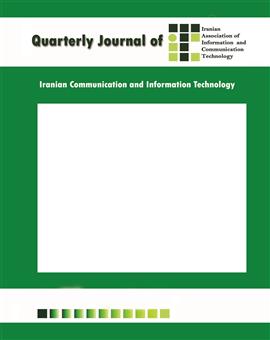Improvement of the bulk sensitivity and FoM of the plasmonic nanodipole antenna array
Subject Areas : ICTSamira Amiri 1 * , Najmeh Nozhat 2
1 -
2 -
Keywords: Figure of Merit (FoM), Nanoantenna, Optical Response, Sensitivity, Sensor,
Abstract :
In this paper, the sensitivity of a plasmonic nanodipole antenna array for different materials of the metal nanodipole and substrate is calculated by changing the refractive index of the surrounding medium. The performance of our proposed array is studied at two wavelengths of 1310 and 1550 nm, the wavelengths of the second and third telecommunications windows. It is shown that by using the silver (Ag) nanodipole instead of the gold (Au) one, the bulk sensitivity of the nanostructure is improved. By replacing the substrate material from Si to SiO2, the sensitivity increases up to 1220 and 1150 nm/RIU at the wavelengths of 1310 and 1550 nm, respectively, that is very suitable for sensing applications. Moreover, the figure of merit (FoM) of the plasmonic sensor is calculated for both substrates and nanodipole materials. The maximum value of the FoM is obtained for the nanoantenna array with SiO2 substrate and Ag nanodipole and it is equal to 14.35. Furthermore, it is shown that by increasing the thickness of the nanodipole, the nanostructure sensitivity and FoM are enhanced
1. T. Okamoto, I. Yamaguchi, and T. Kobayashi, “Local plasmon sensor with gold colloid monolayers deposited upon glass substrates,” Opt. Lett., vol. 25, no. 6, pp. 372–374, 2000.
2. M. M. Miller and A. A. Lazarides, “Sensitivity of metal nanoparticle surface plasmon resonance to the dielectric environment,” J. Phys. Chem. B, vol. 109, no. 46, pp. 21556–21565, 2005.
3. K. S. Lee and M. A. El-Sayed, “Gold and silver nanoparticles in sensing and imaging: sensitivity of plasmon response to size, shape, and metal composition,” J. Phys. Chem. B, vol. 110, no. 39, pp. 19220–19225, 2006.
4. C. L. Nehl, H. Liao, and J. H. Hafner, “Optical properties of star-shaped gold nanoparticles,” Nano Lett., vol. 6, no. 4, pp. 683–688, 2006. 5. S. A. Maier, Plasmonics: fundamentals and applications, Springer, New York, 2007.
6. M. Lamy de la Chapelle and A. Pucci, Nanoantenna: plasmon-enhanced spectroscopies for biotechnological applications, Pan Stanford Publishing Pte. Ltd., USA, 2013.
7. S. J. Zalyubovskiy, M. Bogdanova, A. Deinega, Y. Lozovik, A. D. Pris, K. H. An, W. P. Hall, and R. A. Potyrailo, “Theoretical limit of localized surface plasmon resonance sensitivity to local refractive index change and its comparison to conventional surface plasmon resonance sensor,” J. Opt. Soc. Am. A, vol. 29, no. 6, pp. 994–1002, 2012.
8. P. B. Johnson and R. W. Christy, “Optical constants of the noble metals,” Phys. Rev. B, vol. 6, no. 12, pp. 4370–4379, 1972.
9. D. J. Segelstein, “The complex refractive index of water,” M.Sc. Thesis, University of Missouri, Kansas City, 1981.
10. S. S. Mousavi, P. Berini, and D. McNamara, “Periodic plasmonic nanoantennas in a piecewise homogeneous background,” Opt. Express, vol. 20, no. 16, pp. 18044-18065, 2012.
11. P. Berini, “Bulk and surface sensitivities of surface plasmon waveguides,” New J. Phys., vol. 10, no. 10, pp. 105010-105047, 2008.
12. M. Alavirad, L. Roy, and P. Berini, “Optimization of plasmonic nanodipole antenna arrays for sensing applications,” IEEE J. Sel. Top. Quantum Electron., vol. 20, no. 3, pp. 7–14, 2014.

